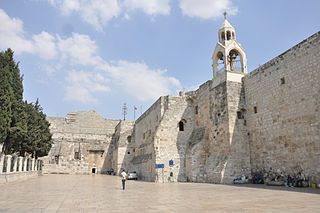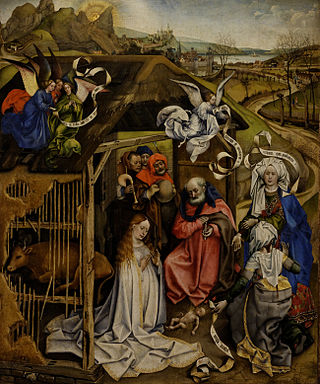Related Research Articles

Bethlehem is a city in the Israeli-occupied West Bank of the State of Palestine, located about ten kilometres south of Jerusalem. It is the capital of the Bethlehem Governorate, and as of 2017 had a population of 28,591 people. The city's economy is largely tourist-driven; international tourism peaks around and during Christmas, when Christians embark on a pilgrimage to the Church of the Nativity, revered as the location of the Nativity of Jesus.

The Gospel of Barnabas is a non-canonical, pseudepigraphical gospel written in the Late Middle Ages and attributed to the early Christian disciple Barnabas, who is one of the apostles of Jesus. It is about the same length as the four canonical gospels combined and largely harmonizes stories in the canonical gospels with Islamic elements such as the denial of Jesus' crucifixion. The gospel presents a detailed account of the life of Jesus. It begins with the nativity of Jesus, which includes the annunciation by the archangel Gabriel to Mary which precedes Jesus' birth. The gospel follows his ministry, ending with the message of Jesus to spread his teachings around the world. Judas Iscariot replaced Jesus at the crucifixion.

Nazareth is the largest city in the Northern District of Israel. In 2022 its population was 78,007. Known as "the Arab capital of Israel", Nazareth serves as a cultural, political, religious, economic and commercial center for the Arab citizens of Israel, as well as a center of Arab and Palestinian nationalism. The inhabitants are predominantly Arab citizens of Israel, of whom 69% are Muslim and 30.9% Christian. The city also commands immense religious significance, deriving from its status as the hometown of Jesus, the central figure of Christianity and a prophet in Islam.

The Church of the Nativity, or Basilica of the Nativity, is a basilica located in Bethlehem, West Bank, Palestine. The grotto holds a prominent religious significance to Christians of various denominations as the birthplace of Jesus. The grotto is the oldest site continuously used as a place of worship in Christianity, and the basilica is the oldest major church in the Holy Land.

The virgin birth of Jesus is the Christian and Islamic doctrine that Jesus was conceived by his mother, Mary, through the power of the Holy Spirit and without sexual intercourse. Christians regard the doctrine as an explanation of the mixture of the human and divine natures of Jesus. The Eastern Orthodox Churches accept the doctrine as authoritative by reason of its inclusion in the Nicene Creed, and the Catholic Church holds it authoritative for faith through the Apostles' Creed as well as the Nicene. Nevertheless, there are many contemporary churches in which it is considered orthodox to accept the virgin birth but not heretical to deny it.

The nativity of Jesus, nativity of Christ, birth of Jesus or birth of Christ is documented in the biblical gospels of Luke and Matthew. The two accounts agree that Jesus was born in Bethlehem, Judaea, that his mother, Mary, was engaged to a man named Joseph, who was descended from King David and was not his biological father, and that his birth was caused by divine intervention. Some scholars do not see the two canonical gospel nativity stories as historically factual since they present clashing accounts and irreconcilable genealogies. The secular history of the time does not synchronize with the narratives of the birth and early childhood of Jesus in the two gospels. Some view the question of historicity as secondary, given that gospels were primarily written as theological documents rather than chronological timelines.

In Christianity, Jesus is the Son of God as chronicled in the Bible's New Testament, and in most Christian denominations He is held to be God the Son, a prosopon (Person) of the Trinity of God.

The Star of Bethlehem, or Christmas Star, appears in the nativity story of the Gospel of Matthew chapter 2 where "wise men from the East" (Magi) are inspired by the star to travel to Jerusalem. There, they meet King Herod of Judea, and ask him:
Where is He who has been born King of the Jews? For we have seen His star in the East and have come to worship Him.

Jesus, also referred to as Jesus Christ, Jesus of Nazareth, and many other names and titles, was a first-century Jewish preacher and religious leader. He is the central figure of Christianity, the world's largest religion. Most Christians believe Jesus to be the incarnation of God the Son and the awaited messiah, or Christ, a descendant from the Davidic line that is prophesied in the Old Testament.

The life of Jesus is primarily outlined in the four canonical gospels, which includes his genealogy and nativity, public ministry, passion, prophecy, resurrection and ascension. Other parts of the New Testament – such as the Pauline epistles which were likely written within 20 to 30 years of each other, and which include references to key episodes in the life of Jesus, such as the Last Supper, and the Acts of the Apostles, which includes more references to the Ascension episode than the canonical gospels also expound upon the life of Jesus. In addition to these biblical texts, there are extra-biblical texts that Christians believe make reference to certain events in the life of Jesus, such as Josephus on Jesus and Tacitus on Christ.

The flight into Egypt is a story recounted in the Gospel of Matthew and in New Testament apocrypha. Soon after the visit by the Magi, an angel appeared to Joseph in a dream telling him to flee to Egypt with Mary and the infant Jesus since King Herod would seek the child to kill him. The episode is frequently shown in art, as the final episode of the Nativity of Jesus in art, and was a common component in cycles of the Life of the Virgin as well as the Life of Christ. Within the narrative tradition, iconic representation of the "Rest on the Flight into Egypt" developed after the 14th century.

Luke 2 is the second chapter of the Gospel of Luke in the New Testament, traditionally attributed to Luke the Evangelist, a companion of Paul the Apostle on his missionary journeys. It contains an account of Jesus's birth in Bethlehem, "its announcement and celebration", his presentation in the Second Temple, and an incident from his childhood. Verses 1–14 are often read during services of worship on Christmas Day.

In all four canonical gospels of the Christian New Testament, the cleansing of the Temple narrative tells of Jesus expelling the merchants and the money changers from the Temple. The scene is a common motif in Christian art.

The Census of Quirinius was a census of the Roman province of Judaea taken in 6 CE, upon its formation, by the governor of Roman Syria, Publius Sulpicius Quirinius. The census triggered a revolt of Jewish extremists led by Judas of Galilee.

The Nativity of Jesus has been a major subject of Christian art since the 4th century.

The annunciation to the shepherds is an episode in the Nativity of Jesus described in the Bible in Luke 2, in which angels tell a group of shepherds about the birth of Jesus. It is a common subject of Christian art and of Christmas carols.

The return of the family of Jesus to Nazareth, also known as the return from Egypt, appears in the reports of the early life of Jesus given in the canonical gospels. Both of the gospels which describe the nativity of Jesus agree that he was born in Bethlehem and then later moved with his family to live in Nazareth. The Gospel of Matthew describes how Joseph, Mary, and Jesus went to Egypt to escape from Herod the Great's slaughter of the baby boys in Bethlehem. Matthew does not mention Nazareth as being the previous home of Joseph and Mary; he says that Joseph was afraid to go to Judea because Herod Archelaus was ruling there and so the family went to Nazareth instead. The Gospel of Luke, on the other hand, does not record the flight to Egypt, and says that Joseph had been previously living in Nazareth, and returned there after the Presentation of Jesus at the Temple.

In the New Testament, Jesus is referred to as the King of the Jews, both at the beginning of his life and at the end. In the Koine Hellenic of the New Testament, e.g., in John 19:3, this is written as Basileus ton Ioudaion.

Jesus of Nazareth: The Infancy Narratives is a book written by Pope Benedict XVI, first published on November 21, 2012, by Image Books. The book is the third and final volume of the author's three-volume meditation on the life and teachings of Jesus Christ. Pope Benedict presents the stories of Jesus' infancy and childhood as being as relevant today as they were two thousand years ago. This third volume in the series was preceded by Jesus of Nazareth (2007) and Jesus of Nazareth: Holy Week (2011).

The date of the birth of Jesus is not stated in the gospels or in any historical sources and the evidence is too incomplete to allow for consistent dating. However, most biblical scholars and ancient historians believe that his birth date is around 4 to 6 BC. Two main approaches have been used to estimate the year of the birth of Jesus: one based on the accounts in the Gospels of his birth with reference to King Herod's reign, and the other by subtracting his stated age of "about 30 years" when he began preaching.
References
- Nammari, Dalia. "Muslim calligrapher writes Luke's Gospel for pope [ dead link ]." The Washington Post . 27 April 2009. (accessed April 27, 2009).